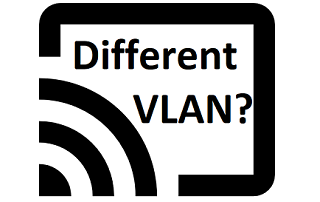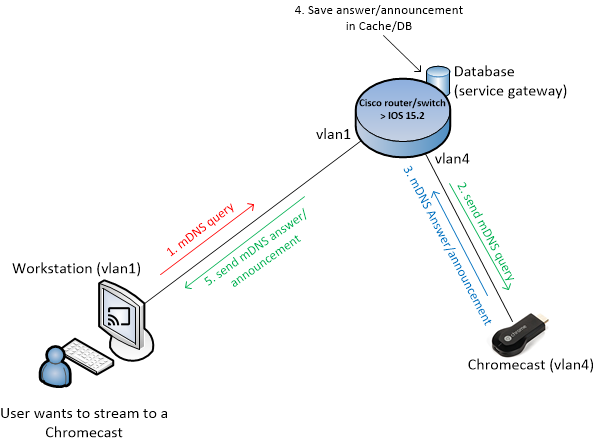There are many questions on using a Chromecast or AirPlay devices (like the new Sonos devices with Airplay2) on a different VLAN. First of all, I think it is a good habbit to put all your IoT devices in a separate VLAN since it’s easier to manage, protect/secure and isolate.;
- IoT devices often use a lot of broadcasts/multicast you don’t want on your workstation LAN.

- IoT devices might not get frequent updates and sit several years with old firmwaress, this implicated a possible security risk.
- You probably want to limit IPv6 to your IoT vlan, having all your devices automatically getting an IPv6 address and being accessible from the internet is not a good idea, especially not with those old kernels ;)
- You don’t want to give anyone who comes in your house or even your kids, access to your Roomba, Philips HUE, Sonos, Chromecasts, lawn robot, etc.
First, let’s set up a default VLAN seperation:
- VLAN1 – Normal/Default VLAN with Workstation(s) and iPhone/iPad
- VLAN4 – IoT
- VLAN11 – Guests (for WiFi Guests)
When having multiple VLANs, we do however want to access the Chromecast and AirPlay from our VLAN1. There are 2 issues we are dealing with:
- Multicasts
- mDNS
Both techniques do not travel across VLANs. There were some people setting up a mDNS reflector like AVAHI and connecting their VLANs (even on Hyper-V), but since the new Cisco IOS 15.2, that’s not needed anymore!
Cisco > IOS 15.2 now offers an mDNS gateway, that in combination with their pim sparse-dense technique, makes it very easy to finally use a Chromecast on a different VLAN.
Example:
Switch# ..... service-list mdns-sd REDISTRIBUTE-IOT-MDNS permit 10 match message-type query ! service-list mdns-sd REDISTRIBUTE-IOT-MDNS permit 20 match message-type announcement match service-type _googlecast._tcp.local ! service-list mdns-sd REDISTRIBUTE-IOT-MDNS deny 30 ! ! service-list mdns-sd QUERY-IOT-MDNS permit 10 match message-type query ! service-list mdns-sd QUERY-IOT-MDNS deny 20 ! ! service-list mdns-sd PERMIT-ALL permit 10 ! ! interface Vlan1 ip address 192.168.0.1 255.255.255.0 description Default VLAN for Workstations and your iPhone/iPad service-routing mdns-sd service-policy QUERY-IOT-MDNS IN service-policy PERMIT-ALL OUT ip pim sparse-dense-mode ! interface Vlan4 ip address 192.168.4.1 255.255.255.0 description IoT VLAN with Chromecasts and Sonos Airplay2 devices service-routing mdns-sd service-policy REDISTRIBUTE-IOT-MDNS IN service-policy PERMIT-ALL OUT ip pim sparse-dense-mode ! interface Vlan11 ip address 172.16.0.1 255.255.255.0 description Guest VLAN for Wireless guests !
How does it work?
As you can see we made 3 service-lists and bind them to the two interfaces. In that way, we allow or deny specific mDNS traffuc between these interfaces:
- On the default/workstation VLAN, when you search for a Chromecast, it will actually do an mDNS query, this query is seen by the Cisco switch and put in a special database: ‘Cisco internal service gateway’. In the above configuration, we only allow mDNS queries into this database: QUERY-IOT-MDNS IN
- On the IoT VLAN, we have to output/send this query (which was send from your workstation or iPhone), so from this ‘Cisco internal service gateway’ it needs to send out: PERMIT-ALL OUT
- The answer/announcement is saved in the service gateway Cache / database (more about this later).
- Once the Chromecast receive this mDNS query, it will answer using an mDNS answer/announcement. So on the IoT VLAN, we need to accept specific announcements to the service gateway: REDISTRIBUTE-IOT-MDNS IN
- On the default/workstation VLAN we need to output this answer: PERMIT-ALL OUT
To add support for Sonos/Airplay2, extend the above example:
Switch# ..... service-list mdns-sd REDISTRIBUTE-IOT-MDNS permit 10 match message-type query ! service-list mdns-sd REDISTRIBUTE-IOT-MDNS permit 20 match message-type announcement match service-type _googlecast._tcp.local ! service-list mdns-sd REDISTRIBUTE-IOT-MDNS permit 30 match message-type announcement match service-type _airplay._tcp.local ! service-list mdns-sd REDISTRIBUTE-IOT-MDNS permit 40 match message-type announcement match service-type _raop._tcp.local ! service-list mdns-sd REDISTRIBUTE-IOT-MDNS deny 50 ! ! service-list mdns-sd QUERY-IOT-MDNS permit 10 match message-type query ! service-list mdns-sd QUERY-IOT-MDNS deny 20 ! ! service-list mdns-sd PERMIT-ALL permit 10 ! ! interface Vlan1 ip address 192.168.0.1 255.255.255.0 description Default VLAN for Workstations and your iPhone/iPad service-routing mdns-sd service-policy QUERY-IOT-MDNS IN service-policy PERMIT-ALL OUT ip pim sparse-dense-mode ! interface Vlan4 ip address 192.168.4.1 255.255.255.0 description IoT VLAN with Chromecasts and Sonos Airplay2 devices service-routing mdns-sd service-policy REDISTRIBUTE-IOT-MDNS IN service-policy PERMIT-ALL OUT ip pim sparse-dense-mode ! interface Vlan11 ip address 172.16.0.1 255.255.255.0 description Guest VLAN for Wireless guests !
Also notice that on the VLAN1 and VLAN4 interface, there is the ip pim sparse-dense-mode command, I will not explain that this post, in short: It is for multicast traffic traveling between the 2 VLANs.
Once you have configured the above, you can add the following (query type) service-list:
service-list mdns-sd ACTIVE-QUERY-CHROMECASTS query service-type _googlecast._tcp.local
and let the Cisco router query the Chromecasts every 110 seconds:
service-routing mdns-sd service-policy-query ACTIVE-QUERY-CHROMECASTS 110
The advantage of this is that the internal service gateway has always up-to-date info on the Chromecasts (when it is turned on/off), so the cache of this internal service gateway can immediatelly respond to a query of your iPhone asking if there are any Chromecasts.

Leave A Comment